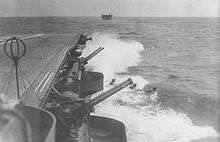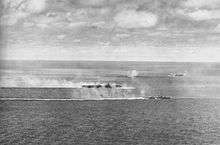Japanese aircraft carrier Zuikaku
 Zuikaku at Kobe on 25 September 1941 after launching, awaiting delivery to the Imperial Japanese Navy. | |
| History | |
|---|---|
| Name: | Zuikaku |
| Namesake: | Japanese: ずいかく Kanji: 瑞鶴 "Auspicious Crane") |
| Laid down: | 25 May 1938 |
| Launched: | 27 November 1939 |
| Commissioned: | 25 September 1941 |
| Struck: | 26 August 1945 |
| Fate: | Sunk by air attack in the Battle of Leyte Gulf on 25 October 1944 |
| General characteristics | |
| Class and type: | Shōkaku-class aircraft carrier |
| Displacement: | 29,800 normal tons, 32,000 tons full load |
| Length: | 257.5 m (844 ft 10 in) |
| Beam: | 26 m (85 ft 4 in) |
| Draft: | 8.9 m (29 ft 2 in) |
| Propulsion: |
|
| Speed: | 34.5 knots (63.9 km/h) |
| Range: | 7,581 mi (6,588 nmi) at 18 kn (21 mph; 33 km/h) Fuel: 4100 tons |
| Complement: | 1,660 |
| Armament: |
|
| Aircraft carried: |
|
Zuikaku (Japanese: 瑞鶴 "Auspicious Crane") was a Shōkaku-class aircraft carrier of the Imperial Japanese Navy. Her complement of aircraft took part in the attack on Pearl Harbor that formally brought the United States into the Pacific War, and she fought in several of the most important naval battles of the war, before being sunk during the Battle of Leyte Gulf.[2]
One of six carriers to participate in the Pearl Harbor attack, Zuikaku was the last of the six to be sunk in the war (four in the Battle of Midway and Shōkaku in the Battle of the Philippine Sea).
Service history

In 1941, Zuikaku, under the command of Captain Yokokawa Ichibei, and her sister ship Shōkaku comprised Carrier Division 5. On 26 November 1941, she left Hitokappu Bay for the attack on Pearl Harbor as part of the Kido Butai ("Mobile Force"). Her aircraft complement consisted of 15 Mitsubishi A6M fighters, 27 Aichi D3A dive bombers, and 27 Nakajima B5N torpedo bombers. On 7 December, she launched two waves of aircraft against American military installations on the island of Oahu. In the first wave, 25 dive bombers attacked Wheeler Army Airfield and five fighters attacked the airbase at Kaneohe. In the second wave, 27 torpedo bombers, armed with bombs, attacked the airbase at Hickam Field and 17 dive bombers targeted the battleships USS California and Maryland on Battleship Row at Pearl Harbor. California later sank, while Maryland escaped Pearl Harbor with moderate damage.
Zuikaku's aircraft also attacked the Australian bases at Rabaul on 20 January 1942 and Lae in New Guinea on 21 January. In April 1942, she took part in the Indian Ocean raid, striking the British naval bases at Colombo and Trincomalee on Ceylon, and sinking the Royal Navy aircraft carrier HMS Hermes and the heavy cruisers HMS Cornwall and Dorsetshire, also with the help of Shōkaku.
Battle of the Coral Sea
In May 1942, she was assigned along with Shōkaku to support Operation Mo, the invasion of Port Moresby, New Guinea. Alerted by intercepted and decrypted Japanese naval messages, the Americans dispatched the carriers USS Yorktown and Lexington to stop this operation. On 8 May 1942, during the Battle of the Coral Sea, the main carrier forces located one another and launched maximum-effort raids, which passed each other in the air. Hidden by a rain squall, Zuikaku escaped detection, but Shōkaku was hit three times by bombs and was unable to launch or recover her aircraft. In return, torpedo and dive bombers from both ships hit Lexington, which was later scuttled by torpedoes from an escorting destroyer. Zuikaku was undamaged in the battle, but sustained severe losses in aircraft and aircrew. This required her to return to Japan with her sister ship for resupply and aircrew training, and neither carrier was able to take part in the Battle of Midway in June 1942.
Battle for Guadalcanal
In August 1942, commanded by Captain Tameteru Notomo, Zuikaku was dispatched as part of Carrier Division One along with the repaired Shōkaku and the light carrier Zuihō to oppose the American offensive in the Solomon Islands. On 24 August 1942, in the Battle of the Eastern Solomons, her aircraft severely damaged the carrier USS Enterprise. She was based at Truk for the next few months.
On 26 October 1942, in the Battle of the Santa Cruz Islands, her aircraft again damaged the repaired Enterprise, and crippled USS Hornet (Hornet was abandoned after a failed scuttling attempt and later sunk by Japanese destroyers). However, Shōkaku and Zuihō were both severely damaged by American air attacks, and Zuikaku had to recover their surviving aircraft in addition to her own. Of the 110 aircraft launched by the three Japanese carriers, only 67 returned to Zuikaku. She then returned to the home islands via Truk for training and aircraft ferrying duties.

In February 1943, she covered the evacuation of Japanese ground forces from Guadalcanal. In May, she was assigned to a mission to counterattack the American offensive in the Aleutian Islands, but this operation was cancelled after the Allied victory on Attu on 29 May 1943. Later in 1943, under the command of Captain Kikuchi Tomozo, she was again based at Truk and operated against U.S. forces in the Marshall Islands.
Battle of the Philippine Sea
In 1944, she was based at Singapore. In June, she was assigned to Operation A-Go, an attempt to repulse the Allied invasion of the Mariana Islands. On 19 June, in the Battle of the Philippine Sea, Taihō and Shōkaku were both sunk by American submarines, leaving Zuikaku, the only survivor of Carrier Division One, to recover the Division's few remaining aircraft. On 20 June, a bomb hit started a fire in the hangar, but Zuikaku's experienced damage control teams managed to get it under control, and she was able to escape under her own power. After this battle, Zuikaku was the only survivor of the six fleet carriers that had launched the attack on Pearl Harbor.
Battle of Cape Engaño

In October 1944, she was the flagship of Admiral Jisaburo Ozawa's decoy Northern Force in Operation Shō-Gō 1, the Japanese counterattack to the Allied landings on Leyte. On 24 October, as part of Third Carrier Division, she launched aircraft along with the light carriers Zuihō, Chitose, and Chiyoda in an ineffective strike against the U.S. Third Fleet. Several of these aircraft were shot down, and the majority of the surviving aircraft did not return to the carriers, instead landing at Japanese land bases on Luzon. However, some of her aircraft made kamikaze attacks and helped sink the light carrier USS Princeton; and most of the others were sent to other surviving carriers and air bases, to later sink the escort carrier USS St. Lo during the Battle off Samar after again using the new kamikaze tactics. The next day, during the Battle of Cape Engaño, she launched her few remaining aircraft for combat air patrol, search, or to join the aircraft already on Luzon. She then came under heavy air attack and was hit by seven torpedoes and nine bombs. With Zuikaku listing heavily to port, Ozawa shifted his flag to the light cruiser Ōyodo. The order to abandon ship was issued at 13:58 and the naval ensign was lowered. Zuikaku rolled over and sank stern-first at 14:14, taking the lives of Rear Admiral (promoted from captain 10 days earlier) Kaizuka Takeo and 842 of the ship's crew; 862 officers and men were rescued by the destroyers Wakatsuki and Kuwa.[2]
Gallery
 Sailors winching up the anchor on the quarter-deck of Zuikaku, 26 November 1941.
Sailors winching up the anchor on the quarter-deck of Zuikaku, 26 November 1941. A Nakajima B5N2 "Kate" taking off Zuikaku to attack Pearl Harbor, 7 December 1941.
A Nakajima B5N2 "Kate" taking off Zuikaku to attack Pearl Harbor, 7 December 1941. Zuikaku during the Battle off Cape Engaño, 25 October 1944.
Zuikaku during the Battle off Cape Engaño, 25 October 1944. The crew of the sinking Zuikaku salute as the flag is lowered on 25 October 1944.
The crew of the sinking Zuikaku salute as the flag is lowered on 25 October 1944.
Notes
- ↑ Bōeichō Bōei Kenshūjo (1967), Senshi Sōsho Hawai Sakusen. Tokyo: Asagumo Shimbunsha, p. 344
- 1 2 Zuikaku @ www.history.navy.mil
Bibliography
- Brown, David (1977). WWII Fact Files: Aircraft Carriers. New York: Arco Publishing. ISBN 0-668-04164-1.
- Brown, J. D. (2009). Carrier Operations in World War II. Annapolis, Maryland: Naval Institute Press. ISBN 978-1-59114-108-2.
- Campbell, John (1985). Naval Weapons of World War Two. Annapolis, Maryland: Naval Institute Press. ISBN 0-87021-459-4.
- Chesneau, Roger (1995). Aircraft Carriers of the World, 1914 to the Present: An Illustrated Encyclopedia (New, Revised ed.). Annapolis, Maryland: Naval Institute Press. ISBN 0-87021-902-2.
- Dickson, W. David (1977). "Fighting Flat-tops: The Shokakus". Warship International. Toledo, Ohio: International Naval Research Organization. XIV (1): 15–46.
- Gill, G. Hermon (1968). Volume II – Royal Australian Navy, 1942–1945. Australia in the War of 1939–1945, Series 2: Navy. Canberra: Australian War Memorial.
- Jentschura, Hansgeorg; Jung, Dieter & Mickel, Peter (1977). Warships of the Imperial Japanese Navy, 1869–1945. Annapolis, Maryland: United States Naval Institute. ISBN 0-87021-893-X.
- Lengerer, Hans (2014). "The Aircraft Carriers of the Shōkaku Class". In Jordan, John. Warship 2015. London: Conway. pp. 90–109. ISBN 978-1-84486-276-4.
- Letourneau, Robert & Letourneau, Dennis (2012). Operation KE: The Cactus Air Force and the Japanese Withdrawal From Guadalcanal. Annapolis, Maryland: Naval Institute Press. ISBN 978-1-61251-179-5.
- Lundstrom, John B. (2005a). The First Team: Pacific Naval Air Combat from Pearl Harbor to Midway (New ed.). Annapolis, Maryland: Naval Institute Press. ISBN 1-59114-471-X.
- Lundstrom, John B. (2005b). The First Team and the Guadalcanal Campaign. Annapolis, Maryland: Naval Institute Press. ISBN 1-55750-526-8.
- Peattie, Mark (2001). Sunburst: The Rise of Japanese Naval Air Power 1909–1941. Annapolis, Maryland: Naval Institute Press. ISBN 1-55750-432-6.
- Polmar, Norman & Genda, Minoru (2006). Aircraft Carriers: A History of Carrier Aviation and Its Influence on World Events. Volume 1, 1909–1945. Washington, D.C.: Potomac Books. ISBN 1-57488-663-0.
- Shores, Christopher; Cull, Brian & Izawa, Yasuho (1992). Bloody Shambles. I: The Drift to War to the Fall of Singapore. London: Grub Street. ISBN 0-948817-50-X.
- Shores, Christopher; Cull, Brian & Izawa, Yasuho (1993). Bloody Shambles. II: The Defence of Sumatra to the Fall of Burma. London: Grub Street. ISBN 0-948817-67-4.
- Stille, Mark (2009). The Coral Sea 1942: The First Carrier Battle. Campaign. 214. Oxford, UK: Osprey Publishing. ISBN 978-1-84908-106-1.
- Stille, Mark (2011). Tora! Tora! Tora:! Pearl Harbor 1941. Raid. 26. Oxford, UK: Osprey Publishing. ISBN 978-1-84908-509-0.
- Stille, Mark (2007). USN Carriers vs IJN Carriers: The Pacific 1942. Duel. 6. Oxford, UK: Osprey Publishing. ISBN 978-1-84603-248-6.
- Tully, Anthony P. (September 2010). "IJN Zuikaku: Tabular Record of Movement". Kido Butai. Combinedfleet.com. Retrieved 14 July 2015.
- Zimm, Alan D. (2011). Attack on Pearl Harbor: Strategy, Combat, Myths, Deceptions. Havertown, Pennsylvania: Casemate Publishers. ISBN 978-1-61200-010-7.
External links
| Wikimedia Commons has media related to Zuikaku. |
Coordinates: 19°20′N 125°51′E / 19.333°N 125.850°E